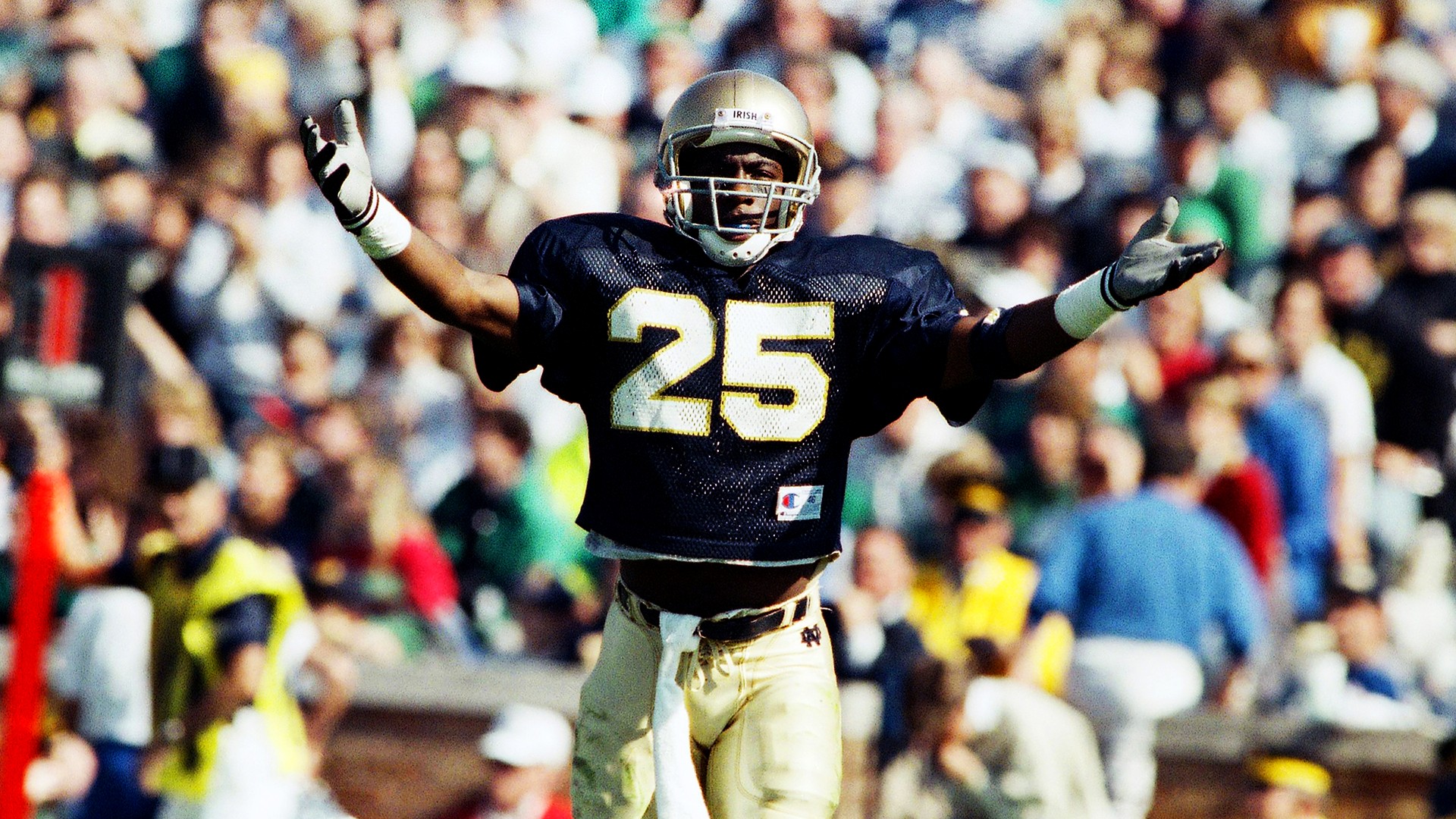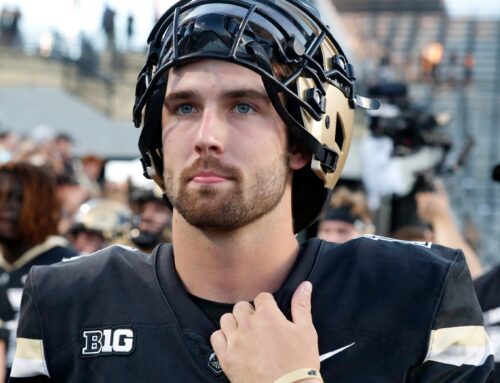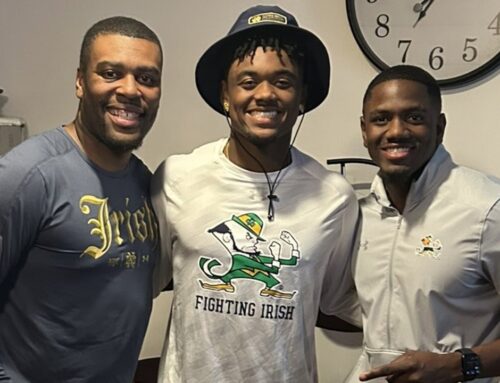Many college football fans don’t know the joy of one of their players winning the Heisman. However, a whole bunch more know about the pain of one of their players not winning the Heisman or getting close and just missing out.
The Fighting Irish have 7 Heisman winners, tied for the most all-time. It’s been a while since Tim Brown brought home the trophy following the 1987 season, though. Today, we’ll take a stroll through history and witness how close (or not close) Notre Dame players have come to taking home college football’s most prized individual trophy.
Congrats on the Votes
RB Creighton Miller, 1943 (4th)
QB Bob Kelly, 1944 (6th)
QB Frank Danciewicz, 1945 (6th)
RB Emil Sitko, 1948 (7th) and 1949 (8th)
RB Nick Pietrosante, 1958 (10th)
WR Jack Snow, 1964 (5th)
RB Vagas Ferguson, 1979 (5th)
RB Allen Pinkett, 1985 (8th)
WR Rocket Ismail, 1989 (10th)
WR Golden Tate, 2009 (10th)
Our biggest collection of players are the ones who received votes and didn’t come close to winning. Miller was one of 3 Notre Dame players to receive votes in ’43 and was 43 votes away from 2nd place, although nowhere near teammate and winner Angelo Bertelli. The following two war years in 1944 and 1945, the Irish quarterback got some love but both were well off pace from winning.
The poor finishes for Sitko in 1948 and 1949–when he was a statistically dominant running back and the Irish never lost–are a bit curious looking back. Doak Walker won it in ’48 and Sitko finished well behind teammate Leon Hart in ’49. Pietrosante collected just 70 votes in 1958 when the top two gained at least 1,000 votes.
As is often the case, Jack Snow couldn’t pull enough votes away from teammate John Huarte who won it all in 1964.
A pair of running backs highlighted the Notre Dame offense in the late 70’s and mid-80’s but never seriously threatened for the award. Ferguson was overshadowed by dominant backs Charles White (USC) and Billy Sims (Oklahoma) while Pinkett was a million points away from Bo Jackson (Auburn) who just edged out Iowa quarterback Chuck Long.
Of course, we’ll have more later on the Rocket. He just sneaked in for the 1989 voting and finished well behind one of his teammates, quarterback Tony Rice.
Tate finishing only 10th in 2009 feels so wrong but such is life when your team goes 6-6. He was the only wide receiver to pick up votes that year. Mr. Suh from Nebraska has a lot of his own beef from 2009, too.
Nearly Multiple Trophies
QB Angelo Bertelli, 1942 (6th)
QB Johnny Lujack, 1946 (3rd)
QB Johnny Lattner, 1952 (5th)
QB Paul Hornung, 1955 (5th)
Here we have a collection of winner’s who had the opportunity to add a second Heisman to their trophy case. Georgia running back Frank Sinkwich ran away with the ’42 Heisman as Bertelli was bunched up in a group from 3rd through 10th separated by just 39 votes. Lujack was solidly in 3rd place for 1946 but quite a ways away from winning running back Glenn Davis despite the Army runner having teammates finish in 4th and 5th place.
The 1952 race was fairly close, although Oklahoma running back Billy Vessels won by 158 votes with Lattner falling 272 votes back. A few years later, Ohio State running back Howard Cassady demolished the field with Paul Hornung finishing way back in 5th place.
You may have noticed no one from Notre Dame won the Heisman before their senior year then finished with votes in another season afterward. Each of these Irish players would win the award the very next season in their last on campus.
The Non-Traditional
OT Joe Beinor, 1938 (9th)
OT Jim White, 1943 (9th)
TE Monty Stickles, 1959 (8th)
DT Mike McCoy, 1969 (6th)
DT Walt Patulski, 1971 (9th)
DE Ross Browner, 1977 (5th)
TE Ken MacAfee, 1977 (3rd)
Jack Snow could be in this category, too. He was just the second receiver ever to gain votes for the Heisman behind Maryland’s Gary Collins in 1961.
Beinor, White, and Stickles finished way back despite All-American seasons. Mike McCoy was the first Notre Dame player featured only on defense to garner Heisman votes. In the 1969 season he joined two other defenders picking up votes in Penn State DT Mike Reid and Tennessee LB Steve Kiner. Two years later, future No. 1 pick Walt Patulski was the only defender in the country to pick up votes.
The 1977 race is interesting to look back upon knowing no one came close to catching Texas running back Earl Campbell. Yet, perhaps the greatest Notre Dame tight end and defensive lineman in school history featured in the race while defeating Campbell’s Longhorns in the Cotton Bowl to secure a National Championship. How would the voting have looked if they waited until after bowl season?
In the Neighborhood
RB Bill Shakespeare, 1935 (3rd)
RB Nick Eddy, 1966 (3rd)
RB Reggie Brooks, 1992 (5th)
The Bard of South Bend finished third in the first-ever Heisman race falling short of Chicago running back and all-around threat Jay Berwanger.
Eddy’s explosive 1966 season saw him finish well behind winner Steve Spurrier at Florida. However, this remains the highest finish for a Notre Dame running back in the modern era.
Speaking of explosive, Brooks flirted with many school records in 1992, broke some others, and is the last Irish running back to pick up Heisman votes.
The Other Quarterbacks
QB Bob Williams, 1949 (5th) and 1950 (6th)
QB Ralph Guglielmi, 1954 (4th)
QB Terry Hanratty 1966 (8th), 1967 (10th), 1968 (3rd)
QB Tom Clements, 1974 (4th)
QB Tony Rice, 1989 (4th)
QB Brady Quinn 2005 (4th) and 2006 (3rd)
Half of these quarterbacks picked up votes in multiple seasons, including Hanratty for an impressive 3 straight years! While he finished 3rd as a senior he was absurdly behind winner O.J. Simpson at USC.
Bob Williams finished in between teammates Leon Hart (the winner) and the aforementioned Sitko in 1949 and likely suffered heavily from a shocking poor year from Frank Leahy and the team the next season. A few years later, Guglielmi had an impressive finish as the top quarterback in a close-ish race led by Wisconsin running back Alan Ameche.
Clements was also the top quarterback to receive votes in 1974 but was well behind Archie Griffin’s first Heisman season. Forgive me for thinking Tony Rice got a little of the “quarterback on a top team” bump in 1989 where he (and no one else) could hold a candle to Andre Ware’s high-flying Heisman season.
PJ recently touched upon Brady Quinn’s place in the Heisman races for 2005-06. He had no shot behind Reggie Bush, Vince Young, and Matt Leinart in the former year and flopped a bit too much in the big games in the latter year which turned out to be an extremely winnable season since Ohio State’s Troy Smith at quarterback broke the record for the highest percentage of first-place votes.
The Closest Calls
QB Angelo Bertelli, 1941 (2nd)
QB Joe Theismann, 1970 (2nd)
WR Rocket Ismail, 1990 (2nd)
LB Manti Te’o, 2012 (2nd)
Finishing second is never easy. Ohio State, Texas, and Penn State have each witnessed 3 seasons apiece, while USC and Georgia join Notre Dame with 4 seasons with a Heisman runner-up. Heading into 2020, Stanford (6) trails Oklahoma (7) for the most second-place finishes.
I’ll rank each of these seasons by their level of egregiousness:
#4 Te’o
This one never bothered me because Te’o cleaned up every other national award he was nominated for and Johnny Manziel truly was a special talent who broke some absurd SEC records set by Tim Tebow and Cam Newton. If Manziel were an Irish quarterback in 2012 he would’ve nearly doubled the record for rushing yards by a quarterback, had the third most rushing yards for any position, totaled the most rushing touchdowns for any position, put up the third most passing yards, with the most total yards by over 1,100 yards, and the most total touchdowns.
#3 Bertelli
This was a long time ago and as a sophomore it’s difficult to get too upset that Bertelli didn’t win, especially during this era. He was outstanding though. The award went to Minnesota running back Bruce Smith since they were the nation’s top team. A common theme in Heisman voting.
#2 Theismann
Stanford did win the Pac-10 this season and quarterback Jim Plunkett took home the award. Looking back, his stats aren’t that great and inferior to the more explosive Theismann–who also made more plays with his feet. It’s especially strange given that Notre Dame was so very close to a National Championship. The name pronunciation change didn’t pay off for Theismann.
#1 Ismail
This will never make sense. Ty Detmer broke a bunch of NCAA records at BYU while throwing for about 250 more attempts than the average Power 5 quarterback in 1990. He got a years worth of hype for beating then No. 1 Miami in week two, never faced another ranked team the rest of the year, lost 2 blowouts during the regular season (and a third in their bowl game), while throwing–wait for it–28 interceptions. This was Rocket’s trophy.





The 1990 theft from Rocket should earn its own category: “Screw Job”
To think the voters handed it to an obscure mediocrity who weeks after receiving the award got torched by 51 points in the Holiday Bowl to an unranked team where he was outclassed by Bucky Richardson.
Harrrumph.
HARRRUMPHHH!
Can’t argue against Manziel with those numbers, and that performance to upset Alabama was one of the most electric games by a player in recent memory. Still, he had a couple clunker games in there early (including a loss to a just OK UF team) and Te’o was by far the best player on the best (regular season) team, so it’s still disappointing Heisman didn’t follow a traditional path there. Totally understand it though with what Manziel did and the defensive bias.
Just a shame timing-wise Manti’s season year couldn’t have been when Mark Ingram or someone else kinda boring was the best offensive player
Manziel won mostly because no one knew who he was when he was playing like ass in losses to Florida and LSU. Put the Bama game early and those 2 losses late and it might have been a different story. I don’t mind that one too much, but it’s a little annoying that he could’ve lost to Bama and our season would’ve ended the exact same way except that Manti would have a Heisman. (One that would be belittled beyond belief given what happened in January, but still.)
Plunkett and Stanford were kind of the new kid on the block, in 1970. Plunkett lead Stanford to the Rose Bowl for the first time since 1952. I disagree that Plunkett’s stats were inferior to Theismann’s. They’re pretty close IMO. Stanford was more dependent on Plunkett’s arm than ND on Theismann’s, as Plunkett threw the ball 120 more times that year. The voting wasn’t close. Theismann is my all time favorite ND player but, I don’t think anyone was surprised when Plunkett won the trophy. Unlike Rocket, which was a travesty.
I’m trying to think of a modern comparison to that year. I guess it would’ve been like 2012 Manziel vs. Alabama’s AJ McCarron except their stats were really close. Or maybe someone from an even lesser school than A&M? The stat comparison:
Plunkett vs. Theismann Stats
ATT: 388 vs. 268
COMP: 211 vs. 155
PERC: 54.4 vs. 57.8
YPA: 7.7 vs. 9.1
PASS: 2980 vs. 2429
TD: 19 vs. 16
INT: 19 vs. 14
RATING: 125.3 vs. 143.2
RUSH: 87 vs. 124
YDS: 209 vs. 384
AVG: 2.4 vs. 3.1
TOTAL TD: 22 vs. 20
YDS/TOUCH: 6.45 vs. 6.51
No doubt, it’s close. And believe me I don’t disagree with your account or that Plunkett wasn’t the easy choice for people back then. But looking back it does seem odd and things are probably different in today’s game.
Like many Heisman races, the schedule broke perfectly for Stanford.
A huge early season win, checked that box. They beat then No. 4 Arkansas in the opener and the Hogs won the rest of their games until being dismantled by Texas. They beat then No. 4 USC in week 5 but the Pac-10 had a really down year overall. USC would lose 3 more times but stayed ranked largely to beating Notre Dame in the finale.
However, Stanford lost in week 3 at home to a Purdue team that finished near the bottom of the Big Ten and had their worst year in 15+ seasons. And with the weak Pac-10 they still lost to a very good Air Force team and lost their rivalry game to a mediocre Cal team.
At the very least, I think the voting was much, much closer today.
Both would have been on TV much more today than back then. It could have been that Plunkett’s best games were when he was on TV. Today maybe his bad ones would have been too. I know that his ancestry was played up by the media back then. Mex./Native American QB at Stanford leading them back to glory..etc.
Today Theismann’s 5 losses in three years would stand out much more than it did during his time under Ara. Ara only lost 3 games in a season once. So 5 losses in three years was pretty much the norm.
I don’t know if it were any “easy choice”. It’s just that the voting turned out to not be close.
OJ killed t̶h̶e̶m̶ it, man